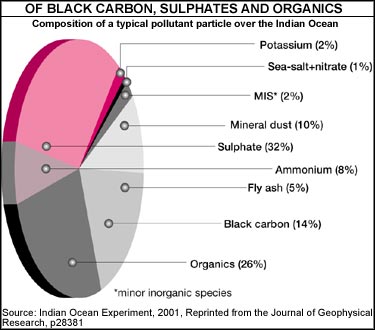Unmasking aerosols
 A P Mitra couldn't believe it. He along with 200-odd scientists from India, Europe, Maldives and the us was conducting an intensive six-week field experiment in 1999 to study the effect of airborne tiny particles called aerosols on climate. The tropical Indian Ocean, where clean air from the southern Indian Ocean including Antarctica and not-so-clean air from the Indian subcontinent meet, provided a unique natural laboratory for this experiment that involved the use of ships, aircrafts, balloons and satellites. As the results started pouring in, the scientists were in for a shock.
A P Mitra couldn't believe it. He along with 200-odd scientists from India, Europe, Maldives and the us was conducting an intensive six-week field experiment in 1999 to study the effect of airborne tiny particles called aerosols on climate. The tropical Indian Ocean, where clean air from the southern Indian Ocean including Antarctica and not-so-clean air from the Indian subcontinent meet, provided a unique natural laboratory for this experiment that involved the use of ships, aircrafts, balloons and satellites. As the results started pouring in, the scientists were in for a shock.
A thick extensive haze layer roughly seven times the size of India had enveloped the northern Indian Ocean. "The haze extends to over 10 million square kilometres (km),' says Mitra of the Delhi-based National Physical Laboratory and one of the three co-chief scientists of the Indian Ocean Experiment (indoex). The Centre for Clouds, Chemistry and Climate at Scripps Institute of Oceanography, University of California, San Diego, coordinated the us $25 million project, 60 per cent of whose funding came from us agencies including the National Aeronautics and Space Administration (nasa).
Seen 1,600 km off the coast, the haze extends from the ocean surface to altitudes of one to three km. Most of the northern Indian Ocean, including the Arabian Sea, much of the Bay of Bengal, and the equatorial Indian Ocean to about 5
